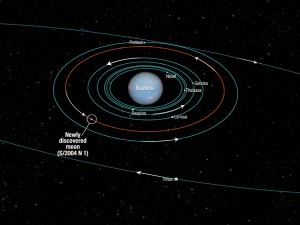NASA finds new moon on Neptune

This diagram provided by NASA shows the orbits of several moons located close to the planet Neptune. NASA announced the discovery of Neptune’s 14th moon Monday, July 15, 2013. The new moon, Neptune’s tiniest, is designated S/2004 N 1. It’s 100 million times fainter than the faintest star visible with the naked eye. AP Photo/NASA
WASHINGTON—A tiny new moon has been spotted circling Neptune— the 14th known to be orbiting the faraway planet, the US space agency said on Monday.
The moon is the smallest ever glimpsed around Neptune and measures just about 12 miles (19 kilometers) across, based on observations from the Hubble Space telescope, NASA said.
Neptune is the farthest planet from the Sun, and NASA said the moon, named S/2004 N1, is about 100 million times fainter than the dimmest star that can be seen with the naked eye.
Astronomers found the moon by tracking a white dot that appeared repeatedly in more than 150 photos taken by Hubble from 2004 to 2009.
Mark Showalter of the SETI Institute in Mountain View, California, found the moon July 1 while studying the faint arcs around Neptune, NASA said.
“The moons and arcs orbit very quickly, so we had to devise a way to follow their motion in order to bring out the details of the system,” he said.
“It’s the same reason a sports photographer tracks a running athlete—the athlete stays in focus, but the background blurs.”
The moon is believed to circle Neptune once every 23 hours.